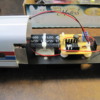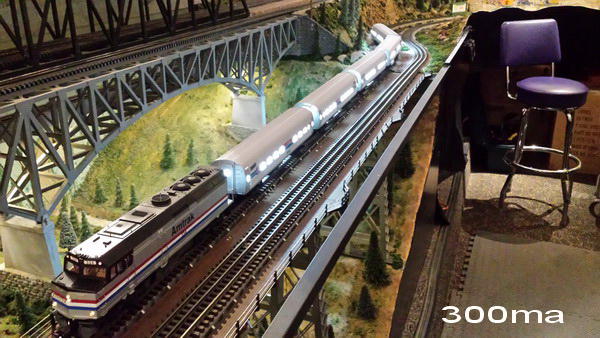A while back I bought some reels of 12v LED strips on sale at MicroMark. I decided to use these strips in my 5 Williams Amtrak metro passenger cars. What I did was make a small circuit board for each car that contained bridge rectifier, capacitor, and 7812 regulator (and 22mh choke) and connected that to the LED strip. That worked well, but a bit too well, as the cars were really bright. And since I decided to use the bright white (5000K) LEDs for the modern passenger cars, it looked like someone had lit up a magnesium block in each of the cars. Then I went back to the forum and reread several LED threads that suggested limiting the LED current to about 20ma. I used my Fluke meter to measure the current that my setup was using and it was about 300ma (okay, so it was a bit high).
I then decided that the easiest way to retrofit my existing circuit boards to lower the amperage was to use the CL2N3 current limiter. I had bought several of these about a year ago after reading a thread by gunrunnerjohn about LED lighting, but forgot that I had these until now. So I took one of the CL2N3 devices an inserted it into the circuit. It worked as advertised and limited the current to 20ma. But since these cars have frosted silhouette windows rather than clear windows, I thought I could benefit from a little more amperage. Since both GRJ and the Supertex data sheet say you can rack and stack these things to get more current, I decided to do just that. But this is where things got weird. The data sheet says you can put additional CL2N3 devices in parallel to get 40ma, 60ma, 80ma, etc. I found that with two in parallel I got 35ma, with three I got 45ma, with four I got 55ma, and with five I got 60ma. Not quite the linear progression that was described in the data sheet.
My question is: Is this normal with these devices? Has anyone tried stacking these things and measuring the current? I seems odd that my results would deviate from the data sheet. And I don't believe that I'm hooking them up wrong, since the connections are not rocket science. Any ideas?
BTW, my question is just out of curiosity since I decided to go with adding 3 of these to each car for 45ma and they work fine.

















